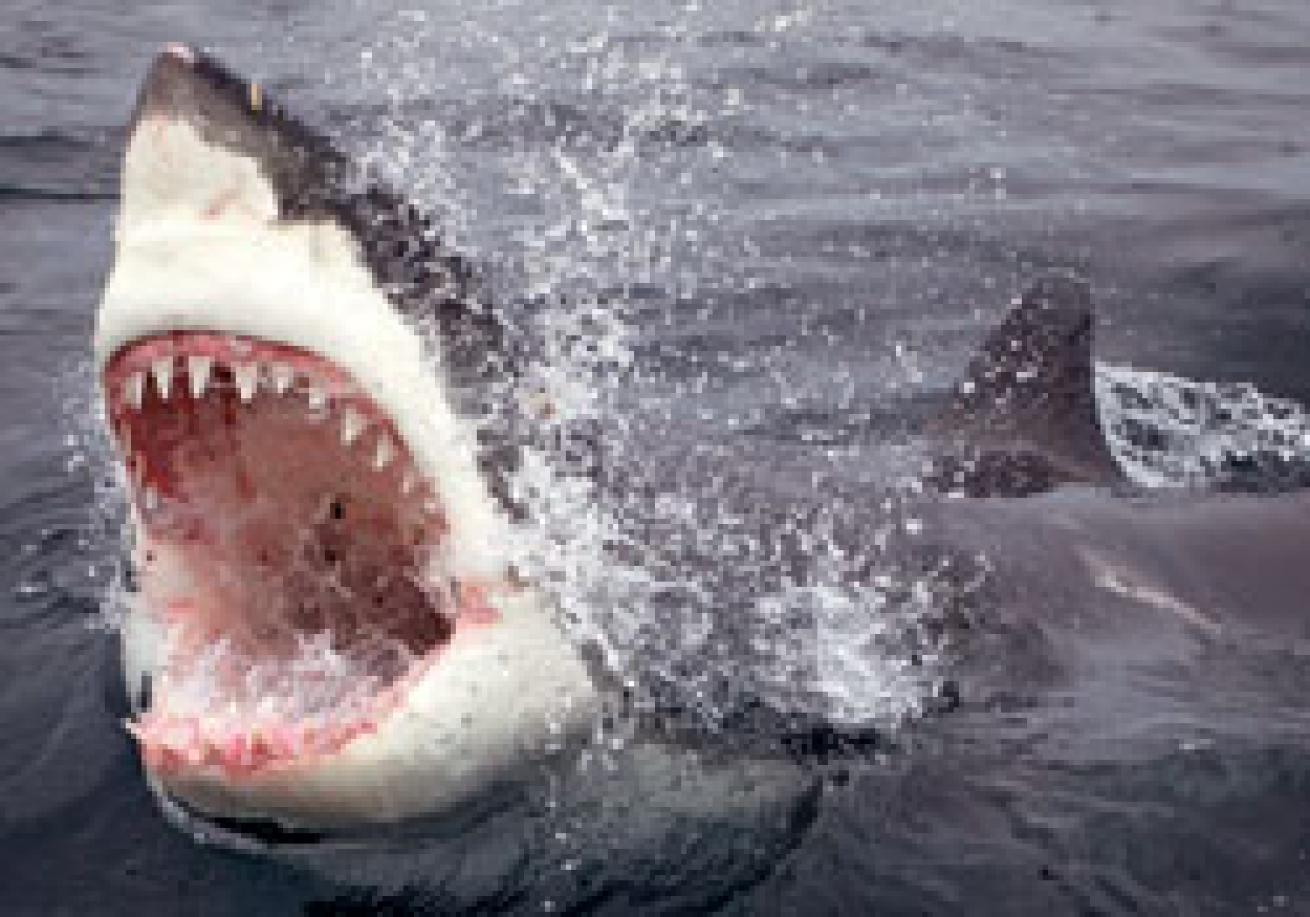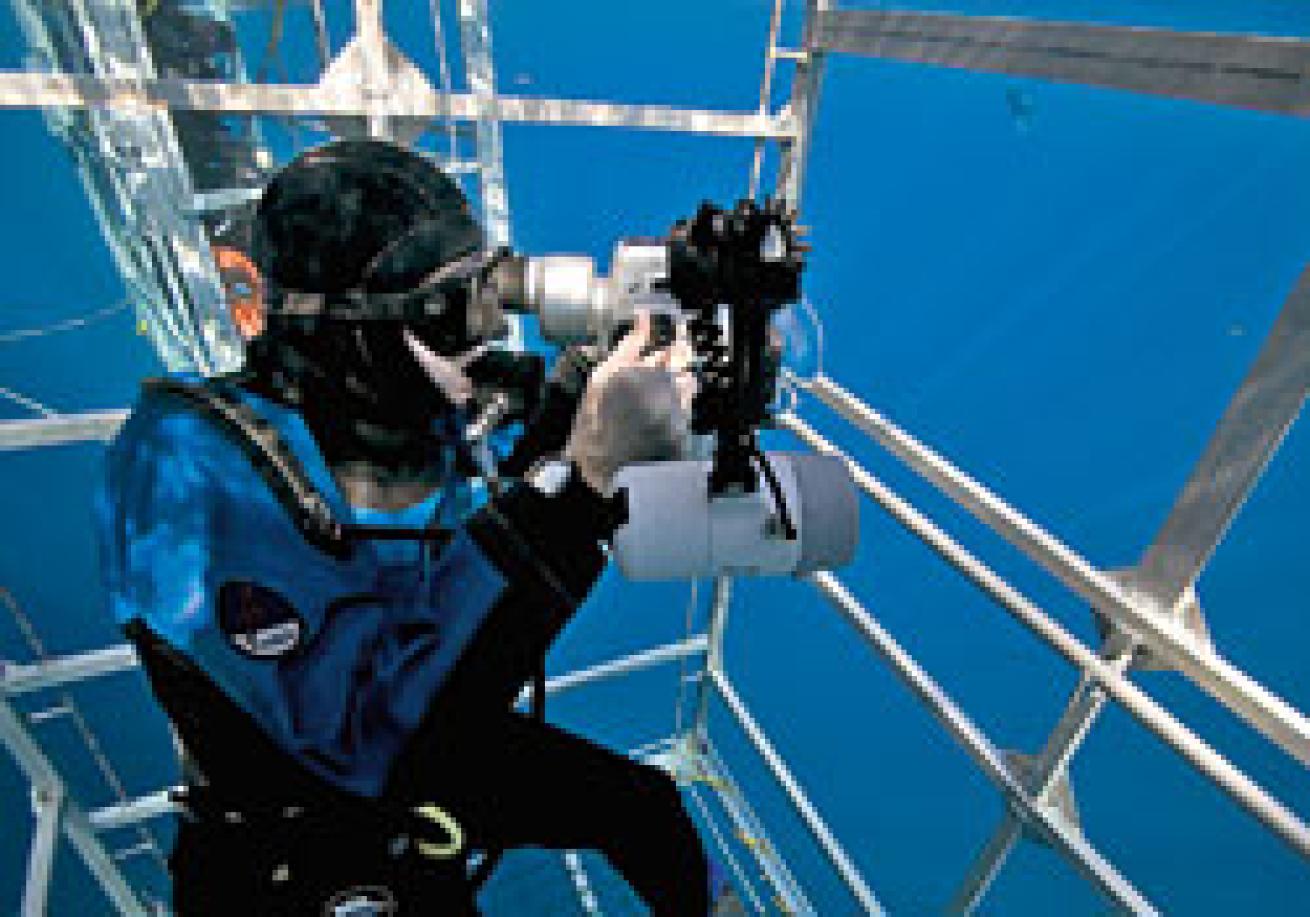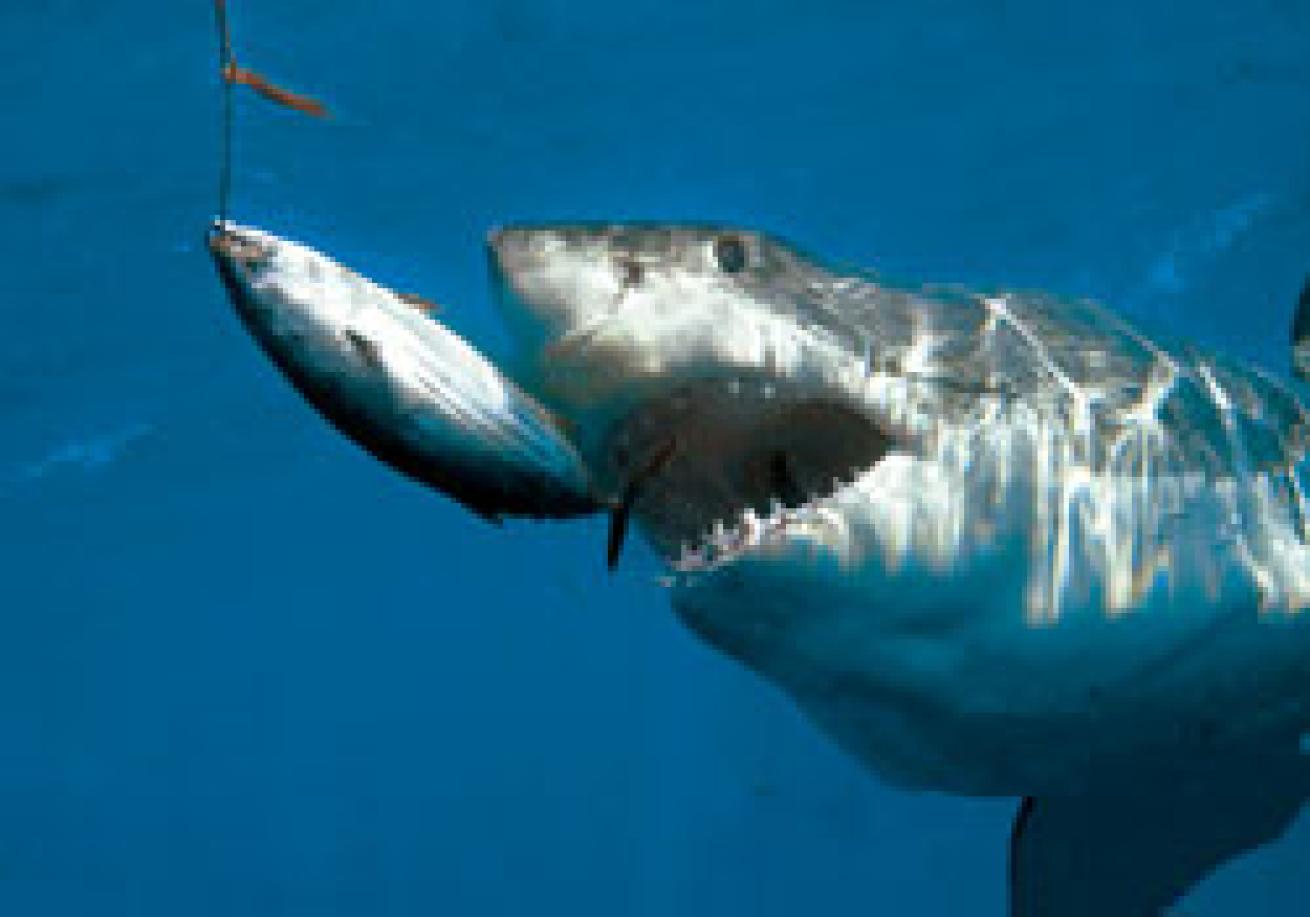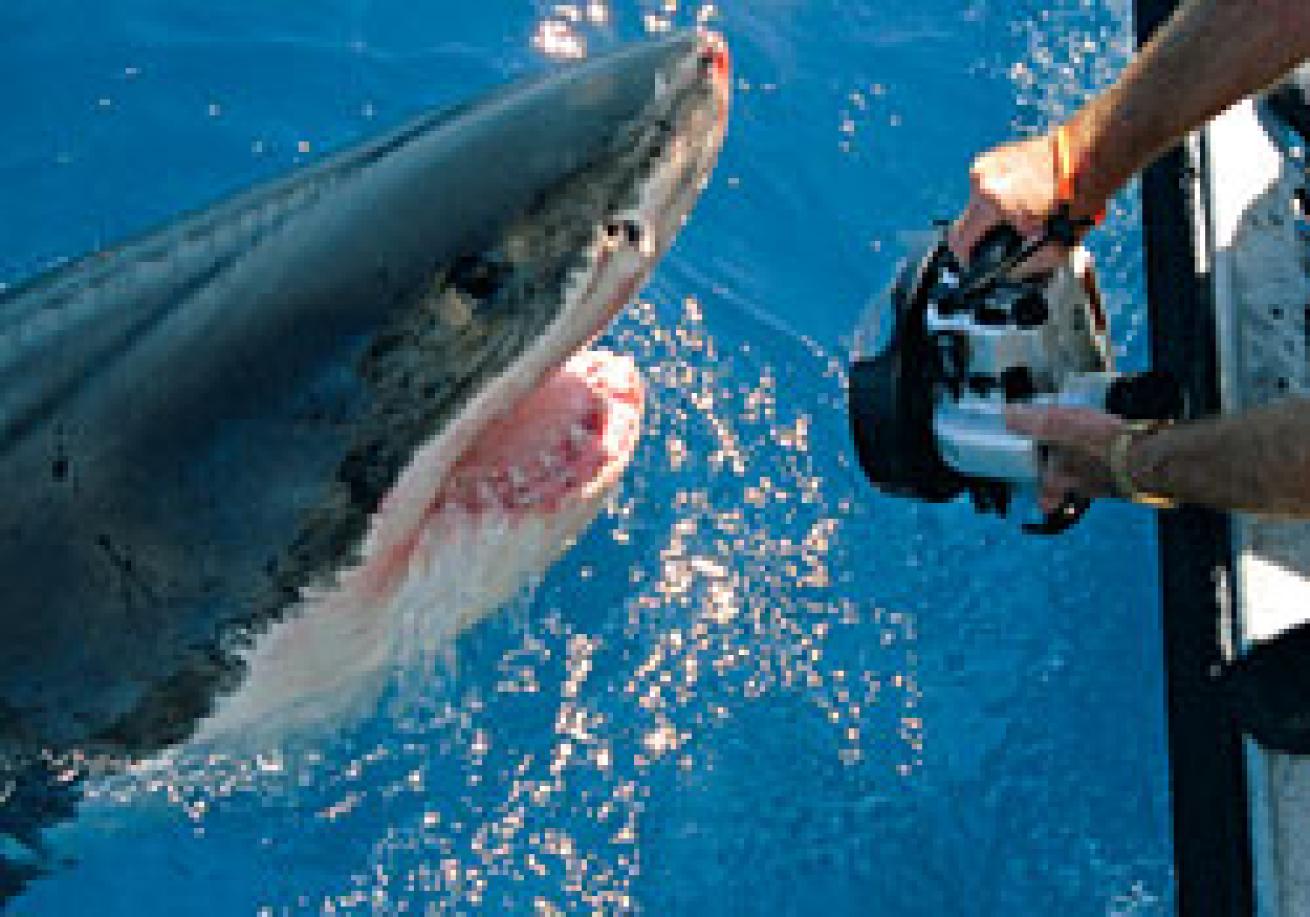Bringing Home the Great White

December 2006
Text and Photography by Stephen Frink
The great white shark is the iconic marine predator--no other fish in the sea communicates the same raw power and menace. But only in the past few years have these sharks become truly accessible to marine photographers. That's not to say underwater photographers haven't been trying, for decades actually, to capture great white shots. It's just that this particular photo-op used to be a lot harder to come by than it is today.
Shooting great whites today means never having to say you're skunked, because there are three places on the planet where dive operators manage to provide reliable, albeit seasonal, great white encounters. Here's where to go to photograph these magnificent animals.
Where The Sharks Are
Guadalupe Island, Mexico
This is the newest destination for white sharking, and easily the most accessible for North American shooters. Located in the Mexican Pacific, Guadalupe is about a 22-hour steam from San Diego, although some boats now offer itineraries from Mexico as well. The season for white shark encounters here is August through November, presumably as the sharks follow the tuna migration. The significant advantage here is reliable shark action in very clear water, and minimal travel time and expense to arrive. There are very professional live-aboards plying these waters, offering wonderful shark cages and good wrangling. The odds are quite good that a skilled shooter will come home with some stellar shots.
South Africa
Off the small fishing village of Gansbaai lies an island hosting a large population of sea lions, ample natural food for the sea's apex predator. Fishermen have long known of the high probability of finding white sharks in these waters, but it is only over the past decade that serious photographers from around the world have been making the pilgrimage, even while backpacking ecotourists have been making day trips from Cape Town--all to experience the adrenaline rush of seeing these sharks in the wild. Proximity--only a 30-minute run from shore in a fast speedboat--and popularity can create a lot of competition for the sharks in residence on any given day.
The South African white shark season is better in our summer, May through September, when the seas are calmer and the visibility is better. Visibility is a relative term here though, as the water is typically green and nutrient-rich. Fifteen- to 20-foot vis is a pretty good day, but when "a player" (local lingo for a cooperative white shark) is working the bait, that's good enough. The shark wranglers are able to finesse the whites right up to the swim platform or cage with a combination of bait, blood and often a decoy cut in the shape of a sea lion. This is the only place I've seen "jawing" occur, where a skilled wrangler can touch the tender snout of the white shark and temporarily place it in a docile state where it rolls back in the water opening and closing its mouth. This is the ultimate topside "bite" shot for the great white. What South Africa gives away in water clarity it makes up in topside potential.
Be aware that South Africa is not nearly as reliable as Guadalupe for daily shark encounters. It's not that the sharks aren't there--they are, in significant numbers--but there are a number boats with savvy operators, each competing to bring the sharks close to their boat.
South Australia
This is where white sharking all began. Back in the early 1970s, affluent shooters could book a trip here with Rodney Fox, the most famous white shark attack survivor. The cost in those days was $7,000 to $10,000, expensive even by today's standards and outrageously so at the time. Supply was there and the demand was sufficient during the short white shark season to fill the boat. This was the Wild West of white sharking, and I regret I did not catch it at its peak.
The reliability of South Australia white shark encounters faded with the overfishing of great whites. Fortunately, fishing for white sharks is now illegal in Australia and the populations have rebounded nicely. In fact, in 2005 I did a tour of all three white shark hot spots in a seven-month time span, and had by far the best combination of topside and underwater encounters in South Australia. The water is clear (although not as clear as Guadalupe) and the sharks are in the Neptune Islands most of the year. Avoid it when the local fishermen are doing their tuna tow, as their incidental kill will pull the white sharks offshore, and in our summer the Great Southern Ocean can be a cold and bouncy place to spend hours in a shark cage. But, at the right time of year, South Australia offers terrific white sharking with very professional shark wranglers.
Photographic Variables
To Strobe or Not To Strobe?
Most underwater white shark encounters happen close to the surface, leading photographers to wonder whether to use a strobe. Sometimes the visibility is pretty grim, whether in South Africa where the water is turbid anyway, or even in Guadalupe due to detritus from the chumming process. Getting the shark close requires artful baiting, and that can create a lot of backscatter when lit with a strobe. Still, I like using strobe light under most circumstances because it provides definition and contrast, and it accents the teeth, arguably the most important detail in a white shark photo. The eyes of a great white shark are black and almost featureless, but a little strobe can bring detail there as well. The times I don't use a strobe are when I'm shooting over/unders or doing polecam work, because the housed camera systems used for either task tend to be fairly cumbersome and the action is very close.
Which Lens?
White shark photography is all about wide-angle lenses. These are big animals, 12 to 16 feet, but it really depends on how close the sharks will approach the cage as to what focal length works best. This past season in Guadalupe, with the sharks relatively distant, Nikon's 17-55mm zoom was a good go-to lens, but with closer encounters the 12-24mm is probably more versatile. On my Canon, I typically use my 17-40mm zoom unless we are getting ultra-close encounters, in which case I'll switch to my 15mm fisheye lens to force the perspective and make a large shark look even more magnificent and menacing. The quick focus and sharp resolution of Nikon's 60mm macro lens is a good choice for a slightly different perspective and tighter head shots, but with a shark this large, it's probably better housed behind a dome than a flat port to restore the topside angle of view of the lens. In this imaging scenario, the flat port's refraction effect is likely a disadvantage.
Topside Opportunities
South Africa is the best for topside white shark images, but to capture the action requires a fast motor drive, short telephoto zoom, and probably strobe fill. It's a hassle to take cameras in and out of housings, so I highly recommend having one camera dedicated to topside work and another for underwater. Ideally, you'll use two cameras with the same camera body so that you have a backup in case salt spray or a flood damages a camera. Some of my favorite white shark images are topside, not only for the drama of these powerful predators splashing and thrashing at the surface, but also because it presents the best view of the teeth and bite capacity.
Cage Protocols
Rarely will you have a shark cage all to yourself. In Guadalupe, four-person cages are the norm, and in Australia two or three people normally occupy a cage. In South Africa, many of the cages are small circular affairs for only one diver, but even there the cages are getting bigger to accommodate more tourists. The diving is done on hookah, a surface supply of compressed air via a long hose and regulator. Divers are heavily weighted to counteract the wave action exerted on the cage and buoyancy of the thick wet or dry suits being used. If strobes are used in a multi-shooter cage, it is more courteous to use a single strobe and single arm rather than an unwieldy double-strobe configuration. Besides, in high ambient light with a subject in open water, dual strobes will probably only add double the amount of backscatter.
Safety Considerations
As the world's white shark encounters become more accessible and predictable, never forget that these are ultra-efficient predators doing what they do for a living as we temporarily interlope. Mistakes can happen. Sharks can get inside a cage by accident--especially when you're dealing with a smaller shark and a cage with a large window--but it's exceedingly uncommon. Actually, the closest I've ever come to getting hurt by a white shark is during topside encounters. Last time I was in South Africa I was leaning on the support strut of the outboard motor, shooting a particularly active white shark to starboard when my friends shouted out in alarm. I jumped up on the top of the motor just in time to avoid a second white shark coming up from behind, headed straight for my ankle. Would he have bitten me? Yes, probably. In terms of stealth predation, they are among the best, a fact we should never forget while in their midst.

December 2006
Text and Photography by Stephen Frink
The great white shark is the iconic marine predator--no other fish in the sea communicates the same raw power and menace. But only in the past few years have these sharks become truly accessible to marine photographers. That's not to say underwater photographers haven't been trying, for decades actually, to capture great white shots. It's just that this particular photo-op used to be a lot harder to come by than it is today.
Shooting great whites today means never having to say you're skunked, because there are three places on the planet where dive operators manage to provide reliable, albeit seasonal, great white encounters. Here's where to go to photograph these magnificent animals.
Where The Sharks Are
Guadalupe Island, Mexico
This is the newest destination for white sharking, and easily the most accessible for North American shooters. Located in the Mexican Pacific, Guadalupe is about a 22-hour steam from San Diego, although some boats now offer itineraries from Mexico as well. The season for white shark encounters here is August through November, presumably as the sharks follow the tuna migration. The significant advantage here is reliable shark action in very clear water, and minimal travel time and expense to arrive. There are very professional live-aboards plying these waters, offering wonderful shark cages and good wrangling. The odds are quite good that a skilled shooter will come home with some stellar shots.
South Africa
Off the small fishing village of Gansbaai lies an island hosting a large population of sea lions, ample natural food for the sea's apex predator. Fishermen have long known of the high probability of finding white sharks in these waters, but it is only over the past decade that serious photographers from around the world have been making the pilgrimage, even while backpacking ecotourists have been making day trips from Cape Town--all to experience the adrenaline rush of seeing these sharks in the wild. Proximity--only a 30-minute run from shore in a fast speedboat--and popularity can create a lot of competition for the sharks in residence on any given day.

The South African white shark season is better in our summer, May through September, when the seas are calmer and the visibility is better. Visibility is a relative term here though, as the water is typically green and nutrient-rich. Fifteen- to 20-foot vis is a pretty good day, but when "a player" (local lingo for a cooperative white shark) is working the bait, that's good enough. The shark wranglers are able to finesse the whites right up to the swim platform or cage with a combination of bait, blood and often a decoy cut in the shape of a sea lion. This is the only place I've seen "jawing" occur, where a skilled wrangler can touch the tender snout of the white shark and temporarily place it in a docile state where it rolls back in the water opening and closing its mouth. This is the ultimate topside "bite" shot for the great white. What South Africa gives away in water clarity it makes up in topside potential.
Be aware that South Africa is not nearly as reliable as Guadalupe for daily shark encounters. It's not that the sharks aren't there--they are, in significant numbers--but there are a number boats with savvy operators, each competing to bring the sharks close to their boat.
South Australia
This is where white sharking all began. Back in the early 1970s, affluent shooters could book a trip here with Rodney Fox, the most famous white shark attack survivor. The cost in those days was $7,000 to $10,000, expensive even by today's standards and outrageously so at the time. Supply was there and the demand was sufficient during the short white shark season to fill the boat. This was the Wild West of white sharking, and I regret I did not catch it at its peak.
The reliability of South Australia white shark encounters faded with the overfishing of great whites. Fortunately, fishing for white sharks is now illegal in Australia and the populations have rebounded nicely. In fact, in 2005 I did a tour of all three white shark hot spots in a seven-month time span, and had by far the best combination of topside and underwater encounters in South Australia. The water is clear (although not as clear as Guadalupe) and the sharks are in the Neptune Islands most of the year. Avoid it when the local fishermen are doing their tuna tow, as their incidental kill will pull the white sharks offshore, and in our summer the Great Southern Ocean can be a cold and bouncy place to spend hours in a shark cage. But, at the right time of year, South Australia offers terrific white sharking with very professional shark wranglers.

Photographic Variables
To Strobe or Not To Strobe?
Most underwater white shark encounters happen close to the surface, leading photographers to wonder whether to use a strobe. Sometimes the visibility is pretty grim, whether in South Africa where the water is turbid anyway, or even in Guadalupe due to detritus from the chumming process. Getting the shark close requires artful baiting, and that can create a lot of backscatter when lit with a strobe. Still, I like using strobe light under most circumstances because it provides definition and contrast, and it accents the teeth, arguably the most important detail in a white shark photo. The eyes of a great white shark are black and almost featureless, but a little strobe can bring detail there as well. The times I don't use a strobe are when I'm shooting over/unders or doing polecam work, because the housed camera systems used for either task tend to be fairly cumbersome and the action is very close.
Which Lens?
White shark photography is all about wide-angle lenses. These are big animals, 12 to 16 feet, but it really depends on how close the sharks will approach the cage as to what focal length works best. This past season in Guadalupe, with the sharks relatively distant, Nikon's 17-55mm zoom was a good go-to lens, but with closer encounters the 12-24mm is probably more versatile. On my Canon, I typically use my 17-40mm zoom unless we are getting ultra-close encounters, in which case I'll switch to my 15mm fisheye lens to force the perspective and make a large shark look even more magnificent and menacing. The quick focus and sharp resolution of Nikon's 60mm macro lens is a good choice for a slightly different perspective and tighter head shots, but with a shark this large, it's probably better housed behind a dome than a flat port to restore the topside angle of view of the lens. In this imaging scenario, the flat port's refraction effect is likely a disadvantage.

Topside Opportunities
South Africa is the best for topside white shark images, but to capture the action requires a fast motor drive, short telephoto zoom, and probably strobe fill. It's a hassle to take cameras in and out of housings, so I highly recommend having one camera dedicated to topside work and another for underwater. Ideally, you'll use two cameras with the same camera body so that you have a backup in case salt spray or a flood damages a camera. Some of my favorite white shark images are topside, not only for the drama of these powerful predators splashing and thrashing at the surface, but also because it presents the best view of the teeth and bite capacity.
Cage Protocols
Rarely will you have a shark cage all to yourself. In Guadalupe, four-person cages are the norm, and in Australia two or three people normally occupy a cage. In South Africa, many of the cages are small circular affairs for only one diver, but even there the cages are getting bigger to accommodate more tourists. The diving is done on hookah, a surface supply of compressed air via a long hose and regulator. Divers are heavily weighted to counteract the wave action exerted on the cage and buoyancy of the thick wet or dry suits being used. If strobes are used in a multi-shooter cage, it is more courteous to use a single strobe and single arm rather than an unwieldy double-strobe configuration. Besides, in high ambient light with a subject in open water, dual strobes will probably only add double the amount of backscatter.
Safety Considerations
As the world's white shark encounters become more accessible and predictable, never forget that these are ultra-efficient predators doing what they do for a living as we temporarily interlope. Mistakes can happen. Sharks can get inside a cage by accident--especially when you're dealing with a smaller shark and a cage with a large window--but it's exceedingly uncommon. Actually, the closest I've ever come to getting hurt by a white shark is during topside encounters. Last time I was in South Africa I was leaning on the support strut of the outboard motor, shooting a particularly active white shark to starboard when my friends shouted out in alarm. I jumped up on the top of the motor just in time to avoid a second white shark coming up from behind, headed straight for my ankle. Would he have bitten me? Yes, probably. In terms of stealth predation, they are among the best, a fact we should never forget while in their midst.






